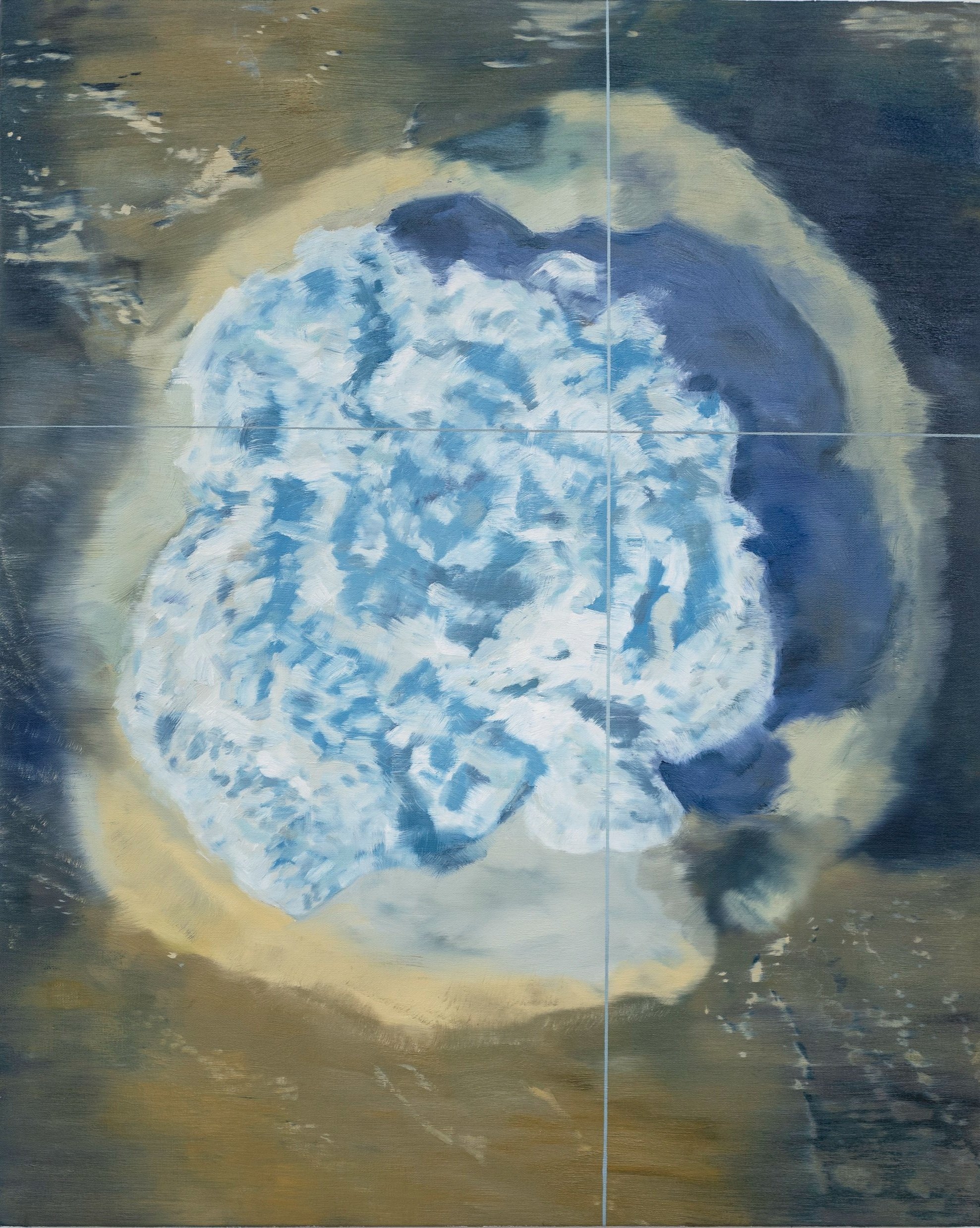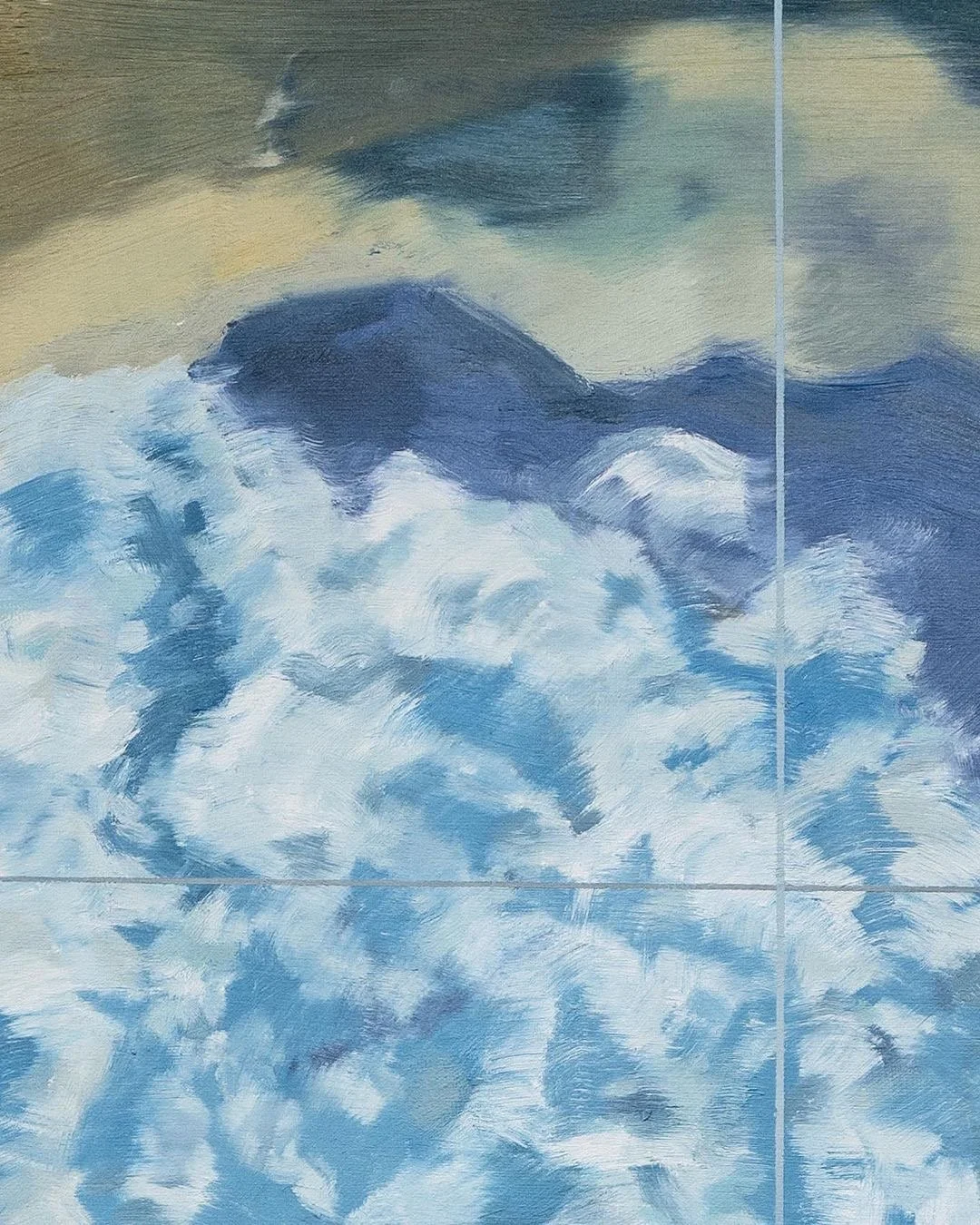Eruption, 2022
Eruption, 2022
Oil on linen
76 x 61 cm (30 x 24 in)
Hung Tonga-Hung Ha'apai, a submarine volcano in the South Pacific, began erupting on December 20, 2021. Four weeks later, on January 15, 2022, the eruption reached a dramatic climax with an enormous explosion recorded by modern instruments. The event caused extensive damage to undersea cables in the surrounding area, severing Tonga's communication with the rest of the world. This disconnection highlighted for Tan Mu the critical role undersea cables play in global information transmission and modern society's reliance on them. Far from being mere physical infrastructure, these cables form the backbone of global connectivity. Five weeks after Tonga's network communication was restored, Tan Mu created Eruption (2022) to replicate and document imagery of Hung Tonga-Hung Ha'apai. At the heart of the painting is a mushroom cloud from the volcanic eruption, shrouding Tonga. Two intersecting lines form a cross, representing the overhead perspective of meteorogram and satellite . This work employs visual language to contemporarily document the event, echoing how modern audiences witnessed the explosion unfolding through screens and media coverage. It invites reflection on the role of technology in shaping contemporary life and explores the profound meanings of connection and disconnection in our interconnected world.
Q: What drew you to focus on the volcanic eruption of Hung Tonga-Hung Ha'apai as a subject for your work?
Tan Mu: I grew up by the sea, with a deep love for the ocean and a passion for extreme sports—I am a freediver. When the Tonga volcano erupted, I had been planning a trip to Tonga to dive with humpback whales. However, the explosion severed the country’s undersea cables, cutting off all communication with the outside world. This event left a profound impact on me. The undersea explosion not only disrupted the island's communications but also prevented the outside world from obtaining information about casualties on the islands until connectivity was restored a month later. This inspired me to document this significant event immediately.
My sensitivity to this event also stems from my grandfather’s influence. He was a marine engineer responsible for port construction and land reclamation projects. Growing up by the sea and being exposed to marine engineering from a young age gave me an understanding of its technical aspects. When Tonga's communications were disrupted, I quickly recognized the importance of this disconnection event and the critical role of undersea cables. This realization motivated me to capture it through painting.
Q: The cross in the painting symbolizes a satellite view. How did you notice this mode of observation, and what is the significance of incorporating this perspective into your work?
Tan Mu: My grandfather was a meteorologist who worked at a weather station. I lived with him during my childhood, and he would teach me daily how to read weather forecasts, analyze cloud patterns, and interpret meteorological maps. His influence instilled in me an early habit of observing changes in the sky and the earth, nurturing my interest in satellite perspectives, contour lines, and weather phenomena.
This way of observing the world made me deeply fascinated with satellite imagery and meteorological maps, profoundly shaping my creative process. I view technology as an extension of the body. Devices like smartphones, microscopes, MRI scanners, and telescopes expand our vision, allowing us to capture information over vast distances, examine microscopic and internal structures, and explore images from outer space. These modern technologies have significantly extended my artistic observation methods. Today’s imaging tools enable us to see details and perspectives that artists centuries ago could never access. These advancements not only enhance my ability to document reality but also push the boundaries of what painting can capture, allowing me to record moments and viewpoints that were previously invisible.
Q: This painting documents a historical event from a contemporary technological perspective. How do you see the role of art in documenting or interpreting such events?
Tan Mu: I see myself as a "human printer" and an archaeologist. I believe artworks serve as enduring physical evidence of significant moments, providing a way to document our era. By painting these collective memories, I aim to imbue them with permanence and meaning. Recording or interpreting through art is essential to my practice. A recurring theme in my work is that art should document the current time, with the potential for the work to evolve with time and even be created for the future. These pieces function as time stamps, allowing us to revisit, reflect on, and expand our understanding. As the world continues to develop, my art persistently captures this evolving present, documenting the essence of our current time.
Q: How does Eruption connect to your ongoing exploration of undersea cables and other infrastructural themes?
Tan Mu: My interest in infrastructure and technology began at an early age. My grandfather was a marine engineer responsible for port construction and land reclamation projects, which exposed me to marine engineering techniques and technological equipment from a young age. However, Eruption holds exceptional significance for me. It marked the beginning of my focus on undersea cables as critical infrastructure and introduced my exploration of the concepts of connection and disconnection. Starting with this work, I delved into the structure of undersea cables, particularly their physical form and function in transmitting information. This research culminated in the creation of Twenty Thousand Leagues Under the Seas (2023). The formal approach of my work evolved from depicting cross-sections of cables to macro representations of entire cable systems in the Signal Series. In this series, I incorporated the concept of mapping into my art, portraying the cable network as a global connectivity map. Through these works, I explore the dual significance of undersea cables—both as physical infrastructure and as conduits for information transmission—while addressing the overarching theme of global connection and disconnection.




